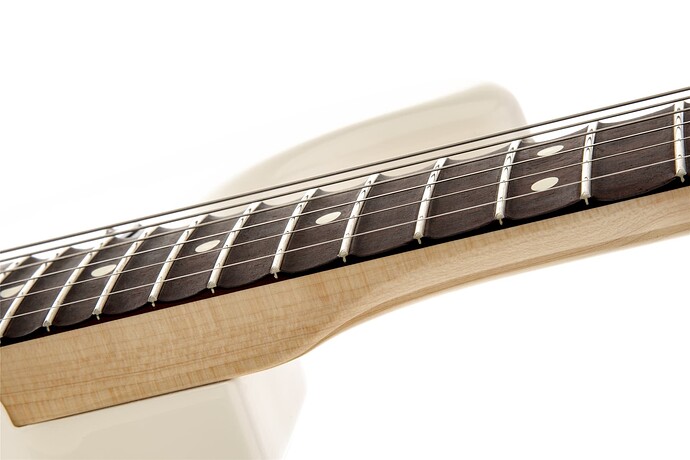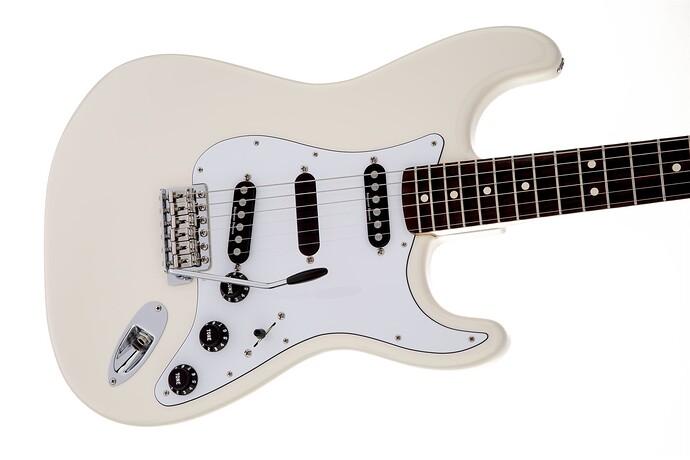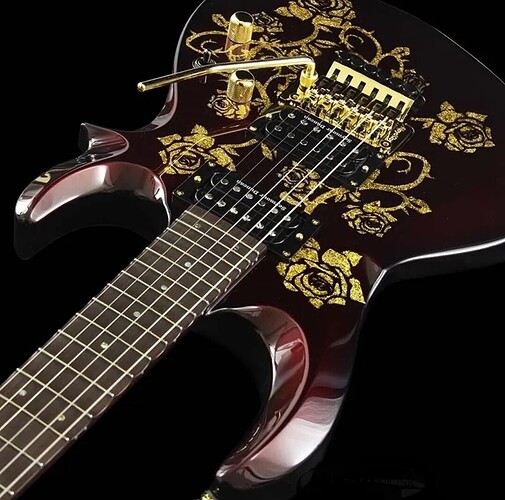Anyone have experience with one of these? There seems to be a lot less information about them online than there is about the Yngwie strat. I’ve played the Yngwie before and felt the scalloping was a bit overkill. The scalloping is what I’m most interested in it seems this type of scalloping is completely exclusive to this guitar.
I own both and like them both. I will try and list some differences as well as describe the Blackmore scallop. The Blackmore has a 7 1/4 radius while the Malmsteen is 9 1/2. In short the Blackmore neck is more “round” in the frets. It is the vintage Fender radius, some like it some don’t. I have a Tele also with the same radius, I don’t mind it. The Malmsteen with the 9.5 is the “modern” fender radius, a little flatter, but not as flat as a 12. The pickup on the Blackmore do have some hum unless they are in mid position which cancels it out. The Malmsteen has very nice noiseless stacked humbuckers, I dont kno w how to describe it other than its a noiseless guitar very nice. The scallops on the Blackmore, are gradual, they start very light at the first fret high E string, but basically aren’t scalloped at the first fret low E and gradually come in as you go down the neck. After the 12th fret it is full scallop, almost as deep as the Malmsteen. All in all both very nice guitars and Id recommend both to anyone who wishes to purchase one. OR do what I did , and acquire both. 
I ended up getting an American Performer Strat with the big 70s headstock, will post some pics once I trick it out the way I want.
Should be an amazing guitar, congratulations!
I was a big Blackmore fan in high school. (Yeah, I’m old.)
This post reminds that I have NEVER played a scaolloped neck. Not even once. I don’t know anyone who has one. Now I’m wondering what it would be like.
I played a Strat years ago and often miss it. (I play a Tele and a PRS SE Custom these days.)
Lovely guitar.
Definitively worth trying out, I played an Yngwie Strat at my local guitar shop and to me, each note sounded really articulate - the notes seemed to pop out rather than blur together when playing fast runs compared to a standard non-scalloped neck. The only downside is the high e string kept slipping off the fretboard (common complaint with them but I’m sure you’d adjust overtime).
I’ve wanted to scallop my Strat ever since but recently enquired how much it would cost and was quoted £500 ($597) so I’m gonna have to save up for while, probably works out cheaper to have one made by Warmoth anyway 
Now I REALLY want to play a scalloped neck, just to see what it’s like. But it’s not an experiment I’d undertake on one of my guitars. 
Been playing a YJM sig strat for a few years now.
I have two guitars, the other is les paul style double cut away traditional.
This seems to be true, there seems to be some added resonance and percussive snap to the neck. I’m one of those who believe the neck influences the tone the most on the guitar.
This is either a crutch or a reason to clean up ones technique, if one is determined, as with overcoming any difficulty it often becomes a strength, in that sense there is an accessibility this guitar lends that’s hard to beat, every millimetre counts, I guess it’s about which side of the fence you want to be if you know what I mean. Some change the bridge to compensate, but I personally would not do it.
Personally the main advantage I get from the scallops is the ability to set as high an action the guitar will allow, I’m tuned 1/2 step down and using stringjoy’s all nickel YJM gauge string spread ( 8 to 46 ). The point is with the scallops you don’t get the fatigue high action would normally give you due to the resistance of the finger board, as with scallops there is never any fingerboard contact or dampening.
This high action thing really needs to be put in the context of this particular string gauge set. There are a zillion shredders out there, killer players, playing with super low action, I personally think their tone and dynamics suffer due to that.
The other thing is that its ‘easier’ to bend.
I’ve been playing on and off lately, the thing I notice going to the strat after weeks of not playing, the first few moments feel very raw with the high action and scallops, like the guitar needs a setup and is kinda broken, five minutes later, it’s all good.
There was a time when going back and forth with my other guitar felt strange due to the scale length change and scallops, but I don’t notice it nearly as much anymore.
As with all such things, one has to experience it, I’m just trying to point out things to look out for, and oh yeah, don’t ever let a string under you nail, it will happen, once.
Yes I agree, to be honest I wouldn’t mod a guitar, I can play faster without scallops, it’s a tone thing as I understand it, as of now. Having said that, I’d always buy scalloped if I had to get another guitar.
Do you think the depth of the scalloping helps with this or is it a law of diminishing returns?
I’m very drawn to the Blackmore style of scalloping.
I tried the Yngwie scalloping but there are some barre style chords I can’t get notes in tune.
Half scalloped on the higher frets is another option, which few production guitars offer. The only production half scalloped neck I’ve seen is on the Japanese exclusive ESP sig for Hizaki from Versailles which is scalloped from 12 to 24.
As for going out of tune, it can happen with big frets or any regular guitar as well now and then, when transitioning that frequency may go up and with time it will return to your baseline.
Honestly if you show me a chord I’m not used to, with my mutton chop fingers I’m sure I’d be out of tune on any guitar till I get it down. I know this is a bit of a cop out but scallops are no different after you start playing them, that period depends on how often you play etc, for some it may take a day or less, others never! The ‘never’ category probably didn’t hit the time spent within a given period’s threshold to make progress.
As far as going deep or shallow, once your fingers don’t interact with the fretboard at all, it makes no difference, perhaps deeper scallops could have an effect on resonance. And the point of scallops is to eliminate the direct interaction with the fretboard entirely, this is my understanding anyways.
But would shallow scallops help with refrets? Another thing on these lines is you can probably get away with more fret levels if you start with big frets, unless it gets so bad you need a new nut, probably easier to fix than a new fret job. Or go with Stainless Steel frets, personally I can’t stand the hammer on tone on SS, attack is too quick, though super slinky with bending.
I guess the question is what are you trying to get of the scallops?
- easier bending
- making higher action easier to play
- think it will help clean up some technique issues
- tone implications
etc…
Impossible to answer without living with a scalloped guitar. It took me more than a year to figure out even the setup of the guitar, sure I though I knew what I liked on day two, but in hind sight, not even close.
I’d say pick a guitar you like, sometimes you can’t explain why, that’s ok, if you can afford it, have no regrets and try it. It’s sometimes like shoes, you see one you just have to have and that’s it.
My advice is work backwards, if you can, like in my case I was into malmsteen, it was a no brainer.
My main reason would be bending and vibrato control.
In that case you don’t want any contact with the fretboard. The blackmore strat would be fine I suppose. Hell, I’d love to have one!
If you have a Dremel with a barrel-sanding attachment it’s not too bad. I was obsessed with scallops long ago and did a few of them with just files and sandpaper, not recommended. If your fingers have a very shallow arch it really makes bending easier, I’ve since increased the arch and lost interest in scallops/big frets altogether.
I’d strongly recommend buying a beater neck and scalloping it yourself, it doesn’t have to be a great job to get an idea whether it’s for you or not.
Been thinking about doing this for a while now, may have to try it!
If you’re thinking of doing it I have a few suggestions based on my experience: first, use a dust mask. Seriously the dust gets everywhere and some woods are really bad for the lungs. Second tape off the neck at least a sixteenth of an inch from the depth you want, final sanding will go deeper than you might think. Third, make a shield for the frets out of aluminum from a soda can or something, one wrong move and the neck is toast.
Even though I don’t play scalloped frets anymore I’m glad I tried it, I was pressing too hard with the left hand and scallops really help out with that; it’s impossible to play in tune otherwise.
I’ve been thinking about buying this guitar lately which comes stock with some scalloped frets
If you have an actual Strat or a guitar with a compatible neck pocket, don’t forget that Warmoth offers scalloping.
I’ve had several Malmsteen Strats in addition to a couple of Blackmore Strats. Good guitars but there are some drawbacks to playing a scalloped neck. As someone mentioned the high E string can slip off the edge of the neck which is annoying.
Plus when you scallop you are removing wood between the frets, what you are really doing is removing the support between the frets. So when you play laterally across the neck the string is flopping back and forth because there is nothing underneath your fingers except air.
This makes for kind of a sloppy and floppy feel.
But the advantage is they do make vibrato and bending easier.
The Blackmore Strat is nice for what it is. It is modeled after an early 70s Strat so it has 3 bolt neck, bullet truss rod vintage tuners 7 1/4 neck radius, it has SD Quarter pounder single coils and no middle pickup with a 3 way switch. The scallops honestly you get used to them pretty quickly the scallops are not a show stopper IMO.




